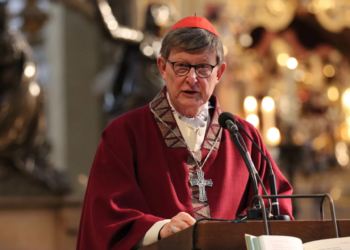CNA Staff, Jun 4, 2025 /
07:00 am
The recent election of Pope Leo XIV has sparked new interest in Catholicism, with Google data showing a spike in searches on “how to become Catholic” shortly after the death of Pope Francis in April. Meanwhile, across many dioceses — and especially among young people — anecdotal reports indicate an upswing in people joining the Catholic Church in recent years.
While the Church’s requirements include some terminology that may be unfamiliar, the process has its roots in the early Church. If you’re looking to become Catholic in 2025, here’s a guide on what you should know — from the stages of spiritual preparation to important terms and historical background on what Christian initiation has looked like over the centuries.
What is OCIA?
The Order of Christian Initiation of Adults or “OCIA” is the normative way to receive formation and prepare to enter the Catholic Church. This process was previously known as RCIA, the Rite of Christian Initiation of Adults, until the U.S. bishops renamed it in 2021 to reflect a more accurate translation of the original Latin.
OCIA has four phases designed to intellectually form and spiritually prepare participants — who have attained the age of reason (generally around the age of 7) — to become Catholic.
What are the stages of OCIA?
Evangelization and Prechatechumenate: The inquirer learns of Christ and is drawn to the Catholic Church; he or she takes part in a period of searching and takes the first step toward becoming Catholic by conversing with a priest or parish director of Christian initiation to become a catechumen.
Catechumenate: Usually over the course of a year or less, a catechumen or candidate takes this time to learn more about the Catholic faith and what it means for his or her life. The Rite of Acceptance into the Order of Catechumens and the Rite of Election take place during this stage.
Purification and Enlightenment: During Lent, a catechumen anticipates his or her initiation into the Catholic Church through prayer and learning. Initiation commonly takes place on the Easter Vigil, which is the culmination of the process where catechumens and candidates receive the sacraments of initiation (baptism, confirmation, and the Eucharist.)
Mystagogy: After being received into the Church, newly initiated Catholics continue to be formed in their faith during what the Church calls the “Period of Mystagogy.” This lasts until Pentecost, the feast 50 days after Easter in which the Church celebrates the birth of the Church, when the Holy Spirit descended on the disciples.
What is the ‘Rite of Election’?
The Rite of Election is the stage of Christian initiation before baptism. Catechumens gather with their sponsors and families, usually on the first Sunday of Lent.
During the Rite of Election ceremony, the local bishop asks the catechumens: “Do you wish to enter fully into the life of the Church through the sacraments of baptism, confirmation, and the Eucharist?” and they respond: “We do.” Catechumens write their names in the Book of the Elect, further confirming their desire to be baptized.
Through this rite, catechumens become known as “the elect.” Only the unbaptized partake in this rite, because those who are baptized are already known as God’s elect.
What’s the difference between a catechumen and a candidate?
Catechumen: A catechumen is someone who is unbaptized and seeking to become Catholic.
(Story continues below)
Subscribe to our daily newsletter
Candidate: A candidate is a baptized Christian seeking to come into full communion with the Catholic Church.
What did Christian initiation look like in the early Church?
While the Second Vatican Council renewed the OCIA process, Christian initiation goes back to the early Church.
In the early Church, before the fourth century, Christian initiation “would have been rather intense,” explained Timothy O’Malley, associate director for research at Notre Dame’s McGrath Institute for Church Life and academic director for the Notre Dame Center for Liturgy.
In its earliest form, Christian initiation would have lasted three years or more.
“There was a real sense of required conversion: If you were an actor (involved with festivals related to the gods) or in the military, you needed to quit,” O’Malley told CNA. “Much catechesis involved moral formation in a new way of life, as well as introduction to the creed.”
OCIA now is largely based on the fourth- and fifth- century model, where catechumens would have prepared for the sacraments of initiation during Lent and entered the Church during the Easter Vigil.
“During the 40 days, they would have fasted, prayed, and gone to regular sermons,” O’Malley said. “We have, for example, sermons on the creed and other dimensions of Scripture.”
Once Christianity could be practiced publicly, “there were new options for initiating people,” O’Malley explained.
“Great public catechists and preachers,” such as Cyril of Jerusalem, John Chrysostom, and Ambrose of Milan, “gave public sermons encouraging people to enroll in the catechumenate leading up to Lent,” he added.
O’Malley noted that some of the reason for changes in the initiation process is that Christianity is not as unknown as it once was.
“The complication today, of course, is that we live in a culture in which Christianity, while not necessarily totally well known, isn’t the novelty of the fourth and fifth centuries,” O’Malley said. “You can get the Lord’s Prayer online or look up the words of the creed on your own (both of these were handed on in secret as part of fourth and fifth century initiation).”
But historical Christian initiation is still connected to today in certain ways.
“But the challenge, in some sense, is always the same: How do you invite people to experience genuine conversion toward discipleship?” O’Malley said. “Christian conversion is not reducible to studying but involves a wholesale change of life: and that we possess in common with the Fathers of the Church.”
How do I join an OCIA program?
To join an OCIA program, reach out to a local Catholic parish. If you have Catholic friends, they may be able to help you with this. A priest or parish leader of Christian initiation may want to meet with you to discuss your desire to become Catholic and help to guide you through the next steps of the process.


















